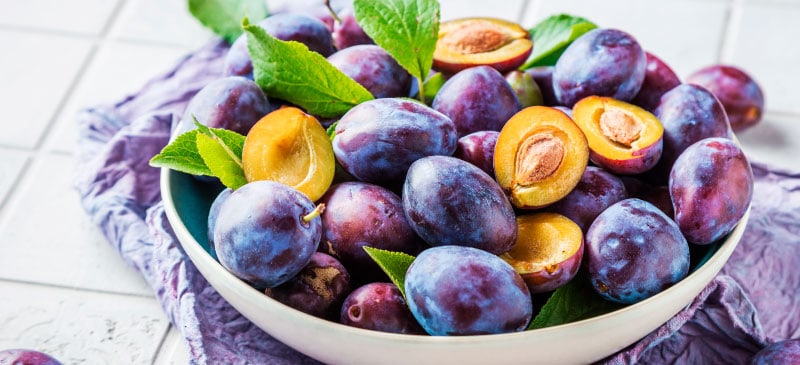
Did you know that plum remains were found in Neolithic Age archaeological sites along with olives, grapes and figs? In fact, plums may have been one of the first fruits domesticated by humans, and when you take into consider the wide range of plum benefits there are, it makes perfect sense.
Those round red plums that you pass in the grocery store during the summer and autumn months are choke-full of antioxidants that help to fight disease and signs of aging, along with a whole host of other plum benefits. That’s not to mention prunes and prune juice, which come from dried plums and help regulate digestion.
When you dig a little deeper into plum nutrition, it’s easy to see why this fruit is valued in traditional medicine for its healing and nourishing effects. Read on to learn more about this wonderful fruit and the plum benefits you can get from eating it.
What Are Plums?
A plum is a fruit of the subgenus and genus Prunus. Plums are in the same family as benefit-rich cherries and peaches, as they are all flowers that make fruit with a groove running down one side and a smooth stone or pit.
Commercial plum trees are medium-sized, usually pruned to 16 feet in height. The plums are usually between one to three inches in diameter, and their shape is globe-like or oval.
Ad

Plums are characterized as drupes. That means the fleshy fruit surrounds a single hard seed.
Plums come in a wide variety of colors and sizes. Some are much firmer-fleshed than others, and the colors range from yellow to white, green and red. The red plum tends to be the most common and popular variety.
The taste of the plum ranges from sweet to tart. The fruit is juicy and delicious when eaten fresh, and it can also be dried, used in jam-making and added to other recipes. Plum juice can even be fermented into plum wine.
Dried plums (or prunes) are also sweet and juicy. Plus, they contain several antioxidants and are considered a top antioxidant food, accounting for the numerous plum benefits.
Plums and prunes are both known for their laxative effect. That is attributed to various compounds present in the fruits, such as dietary fiber, sorbitol and isatin.
Because they aid the digestive system, prunes and prune juice are often used to help regulate the functioning of the digestive system.
A 2013 paper published in Critical Reviews in Food and Science Nutrition suggests that snacking on dried plums may increase satiety and reduce the subsequent intake of food. Thus, the plum benefits health by helping control obesity, diabetes and related cardiovascular diseases.
Despite their sweet taste, dried plums do not cause a major rise in blood glucose and insulin after meals, and plum benefits don’t end there.
Dried plums also affect the gastrointestinal tract by preventing constipation and possibly colon cancer. The bioactive compounds in dried plums, and their metabolites, may also act as antibacterial agents in both gastrointestinal and urinary tracts.
You may have also heard of umeboshi plums, which are a staple in Japanese cuisine. Umeboshi plums are also called “sour plum” or “Japanese plum.” However, they are made from dried and pickled ume fruit, which is closely related to the apricot.
There’s also the kakadu plum, but this type of plum is actually more similar to an almond. It stays on the kakadu plant after ripening and has a similar size to an olive or cherry.
Nutrition Facts
The many plum benefits are a result of its vitamin and mineral content. Plums not only aid digestion, but they’re also known to improve cardiovascular health, boost the immune system, aid skin health, fight free radicals and lower cholesterol.
A one-cup serving of sliced plums (about 165 grams) contains approximately:
- Calories: 76
- Total Carbohydrates: 18.8 g
- Fiber: 2.3 g
- Sugar: 16.4 g
- Total Fat: 0.5 g
- Polyunsaturated Fat: 0.1 g
- Monounsaturated Fat: 0.2 g
- Trans Fat: 0 g
- Protein: 1.2 g
- Sodium: 0 mg
- Vitamin A: 569 IU (19% DV)
- Vitamin C: 15.7 mg (17% DV)
- Copper: 0.1 mg (11% DV)
- Vitamin K: 10.6 mcg (9% DV)
- Potassium: 259 mg (6% DV)
*Daily Value: Percentages are based on a diet of 2,000 calories a day.
In addition, plums contain some vitamin E, thiamine, riboflavin, niacin, vitamin B6, folate, pantothenic acid, calcium, iron, magnesium, phosphorus, manganese and zinc.
Ad

Plum Benefits
1. High Source of Antioxidants
One major plum benefit is its powerful antioxidant properties. Plums provide vitamin C and phytonutrients, such as lutein, cryptoxanthin, zeaxanthin, neochlorogenic and chlorogenic acid. High-antioxidant foods help prevent certain types of cell damage, especially those caused by oxidation.
When certain types of oxygen molecules are allowed to travel freely in the body, they cause what is known as oxidative damage — or the formation of free radicals. Free radicals are very dangerous to the body’s tissues and have been connected to serious health conditions like cancer and premature aging.
The body uses antioxidants to prevent itself from the damage caused by oxygen.
A 2009 study published in the Journal of Medicinal Food suggests that plums are rich in natural antioxidants and protect granulocytes (a type of white blood cells) from oxidative stress. The study was designed to test the anti-radical activity of seven varieties of plums.
Their protective effects against oxidative stress were comparatively evaluated in the white blood cells of mice. Researchers concluded, “The results suggest that individual polyphenolics contribute directly to the total protective effect of plums.”
Some other benefits of eating plums and other antioxidant foods potentially include slower aging, glowing skin, reduced cancer risk, detoxification support and longer life span.
2. Aids Digestion
Plums are a good source of dietary fiber and help regulate the digestive system. Dried plums, or prunes, in particular, are more effective in aiding digestive disorders like constipation.
Consuming plums and other high-fiber foods twice a day may help treat constipation. This is because plums have both soluble and insoluble fiber.
Soluble fiber, which is found in the pulp of a plum, dissolves into a gluey mass. This mass traps fats, sugars, bacteria and toxins and helps move them out of the body. It breaks down carbohydrates, helps lower bad cholesterol levels and may improve cardiovascular health.
Insoluble fiber, found in the skin of a plum, doesn’t dissolve. Its stiff components scrub the digestive tract lining — removing mucoid plaque, trapped toxins and other material.
Thus, plum benefits include being one of the best natural constipation remedies, promoting bowel regulation and steady blood sugar.
A 2016 study published in Molecular Nutrition and Food Research found that the carotenoids and polyphenols found in plums (and cabbages) reduced gastrointestinal inflammation and stimulated digestion in intestinal cells, and more recent animal research unearthed similar findings.
3. Can Lower Cholesterol
Dried plums also can help lower cholesterol levels naturally. The presence of soluble fiber in prunes can help lower LDL cholesterol by interfering with the absorption of dietary cholesterol.
Prunes can lower cholesterol by binding to bile acids and removing them from the body. These bile acids are compounds that are used to digest fat. They are made by the liver from cholesterol.
When they’re removed from the body through stool, the liver must create new bile acids. This uses up more cholesterol, resulting in the lowering of cholesterol in circulation.
4. Helps Improve Cardiovascular Health
The flavonoids and phenolic components — such as anthocyanins, chlorogenic acids, quercetin and catechins — present in plums have anti-inflammatory effects on the different bodily cells. Anti-inflammatory foods help prevent health conditions such as high cholesterol, diabetes and cardiovascular diseases.
The vitamin K present in plums is also beneficial to the heart, so consider addressing the all-too-common vitamin K deficiency right away. This vitamin has been shown to help prevent calcification of arteries, one of the leading causes of heart attacks.
It works by carrying calcium out of the arteries and not allowing it to form into hard, dangerous plaque deposits. Vitamin K helps prevent hardening of the arteries because it can keep calcium out of your artery linings and other body tissues, where it can cause damage.
Some studies show that vitamin K is a critical nutrient for reducing inflammation and protecting cells that line blood vessels, including both veins and arteries. Consuming proper levels of vitamin K is important for preventing high blood pressure and decreasing the chances of cardiac arrest.
A promising 2014 study published in the Journal of Nutrition found that dietary intake of vitamin K is associated with a reduced risk of cardiovascular, cancer or all-cause mortality in a Mediterranean population at high cardiovascular disease risk.
An animal study conducted at the University of Minnesota found that when mice were fed diets containing 0.15 percent cholesterol and dried plum powder for five months, the dried plum powder appeared to help slow the development of atherosclerosis, which is the primary cause of heart disease and stroke.

5. Supports Cognitive Health
The phytonutrients present in plums serve as one of the major plum benefits because they help reduce inflammation in neurological areas, and they improve the ability to learn and retain information. This means that plums can help prevent age-related neurodegenerative disorders.
A 2015 study published in the British Journal of Nutrition states that “aging accompanied by a decline in cognitive performance may be a result of the long-term effects of oxidative stress on neurologic processes.” The study was designed to observe the effects of polyphenol-rich oriental plums on cognitive function and the disposition of protein expression in the brain of mice that were fed a high-cholesterol diet for five months.
The results showed that cholesterol concentrations in both the blood and the brain were significantly higher in the group eating a high-cholesterol diet when compared to the control and high-cholesterol diet with oriental plums groups. Researchers concluded that incorporating oriental plums into a high-cholesterol diet can improve some of the symptoms of neurodegenerative conditions (or neurons in the brain).
READ RELATED: These 5-Ingredient Coconut Cashew ‘Magic Cookies’ Are Packed With Plant-Based Protein
Plums are also considered a nutraceutical fruit that can support cognition due to various factors, including combating inflammation and free radicals.
6. Aids Skin Health
The vitamin C content in plums serves as a benefit to the skin and blood vessels. A 2007 study published in the American Journal of Clinical Nutrition evaluated more than 4,000 women ages 40–74 and found that higher vitamin C intakes lowered the likelihood of a wrinkled appearance, dryness of the skin and helped naturally slow aging.
A scientific review published in 2017 indicates that vitamin C is important for the maintenance of skin. It works as a protective factor against UV-induced photodamage and stimulates collagen synthesis.
Vitamin C is used to form an important protein that helps make skin, tendons, ligaments and blood vessels. It helps with wounds, and it forms scar tissue.
There is even some evidence that using vitamin C skin cream can decrease the amount and duration of skin redness following cosmetic skin procedures, such as wrinkle or scar removal.
7. Boosts Immune System
The vitamin C content in plums is beneficial to individuals whose immune systems are weakened due to stress. Considering that stress has become a common condition in our society, a sufficient intake of vitamin C foods can serve as an ideal tool for one’s overall health.
A 2006 study published in the Annals of Nutrition and Metabolism states that “vitamin C contributes to maintaining the redox integrity of cells and thereby protects them against reactive oxygen species generated during the respiratory burst and in the inflammatory response.”
The results of the study, testing the effects of vitamin C and zinc on clinical conditions, found that adequate intakes of vitamin C and zinc improve symptoms and shorten the duration of respiratory tract infections, including preventing the common cold. Furthermore, vitamin C and zinc reduce the incidence and improve the outcome of pneumonia, malaria and diarrhea infections, especially in children in developing countries.
The anti-inflammatory effects of the polyphenols in plums also help boost immune function, while the oriental plum has shown immunostimulatory effects.
8. Reduces Risk of Diabetes
Diabetes is an illness that causes elevated blood sugar levels. If the pancreas does not produce proper amounts of insulin, or if our cells cannot properly process insulin, it results in diabetes.
Because the glucose is not properly utilized, it accumulates in the bloodstream, resulting in the common indicator of diabetes: high blood glucose or sugar.
Plums have a low glycemic index, and plum extracts aid in the reduction of blood glucose and triglyceride levels in the body. The presence of flavonoids is another plum benefit because they protect the body against insulin resistance.
The presence of soluble fiber in plums helps normalize blood sugar levels. Soluble fiber helps the stomach empty at a slower rate.
This affects blood sugar levels and has a beneficial effect on insulin sensitivity. It also helps control diabetes.
Results from three prospective longitudinal cohort studies show that greater consumption of specific whole fruits, including prunes and plums, is associated with a lower risk of type 2 diabetes, whereas greater consumption of fruit juice is associated with a higher risk.
9. Boosts Bone Health
The polyphenols and potassium in plums are beneficial to the bones because they enhance bone density and prevent bone loss. This can be extremely helpful for people with osteoporosis.
The potassium found in plums is needed to help protect bones from becoming weak and prone to breaks or fractures. When people have low potassium levels, their bones are not properly buffered from the effects of sulfer acids, and they can become demineralized, weak and porous. This is what increases the risk for osteoporosis and fractures.
Osteoporosis is when small holes or weakened areas are formed in the bone that can lead to fractures, pain and even a Dowager’s hump. It’s generally seen in older women over the age of 50.
The main causes of osteoporosis include aging, emotional stress, nutritional deficiencies and hormonal imbalances. Plums, and other high-potassium foods help strengthen bones and improve bone formation.
In fact, a 2017 study conducted on postmenopausal women concluded that “the findings of our studies and others strongly suggest that dried plum in its whole form is a promising and efficacious functional food therapy for preventing bone loss in postmenopausal women, with the potential for long-lasting bone-protective effects.”
Uses in Traditional Medicine
In traditional medicine, tart or sour foods are consumed in colder months in order to benefit liver qi and nourish the lungs. When the temperature outside gets colder and respiratory conditions become more prevalent, eating plums is meant to help eliminate this dampness.
Prunes are used in traditional medicine for their laxative effects. Eating prunes can help aid digestion and relieve constipation. They are also used in improve heart health because of their fiber content.
Plum vs. Prune vs. Peach
Prunes are plums that have been dried naturally. Actually, the term “prunes” is dying out in popularity.
Nowadays, the official term is “dried plums.” Most prunes that you find in the grocery store come from certain plum trees that grow plums that can be dried while still containing the seed.
Many people turn to prunes for their fiber content in order to relieve constipation and other digestive issues. You get all of the benefits of plums packed into a dried-up, wrinkly prune.
However, keep in mind that a cup of sliced plums and a cup of prunes are not equivalent when it comes to their nutrition content. Prunes contain higher concentrations of most nutrients, but they also contain more calories and sugars per serving, so don’t overdo it.
Some people find the idea of eating prunes less than appealing, so they turn to prune juice for its mild laxative effect. Prune juice can also help strengthen bones and improve heart health.
The peach is a fresh fruit that belongs to the same genus as plums. Like plums, peaches are packed with disease-fighting antioxidants, including all five classifications of carotenoids.
Peach nutrition also includes a good amount of vitamin A, vitamin C and potassium. Head-to-head, however, plums provide higher amounts of these micronutrients.
Like plums, peaches can be consumed to boost the health of your heart, eyes, skin and digestion. They help reduce inflammation and fight oxidative stress that contributes to disease.
Uses
You can find fresh plums in your local grocery store or farmers market in the summer and autumn months, usually from the end of May to October.
When shopping for fresh plums, look for ones that are slightly firm and that yield somewhat to pressure. Don’t go for the plums that are already soft or bruised.
If the plum has a sweet aroma, it’s ready to eat. And don’t forget that you can eat the skin of plums when you eat them fresh, but some recipes call for peeled plums too.
Plums should be stored in the refrigerator, unless the plum is too firm and you want it to ripen quickly — then keep it at room temperature in a dark place, like a paper bag.
There are so many fun and healthy ways to incorporate plums into your diet. Plums make a great addition to so many baked goods, snacks and salads. Try adding this delicious fruit to:
- tarts
- pies
- ice pops
- salads
- oatmeal
- yogurt
- smoothies
- pudding
Dried plums are available year-round. They are also beneficial to your health.
Just like fresh plums, they can be added to a number of healthy dishes. They are soft, sweet and deeply flavored.
Sometimes people mix prunes and port wine or brandy to intensify the flavor. Use dried plums, or prunes, in:
- cake
- ice cream
- dressings
- salads
- chicken dishes
- pork dishes
- pancetta dishes
- dinner tarts
Plums are great with breakfast. They’re soft, sweet and easy to digest. Adding them to your morning yogurt or oatmeal is a great way to take advantage of these amazing plum benefits.
Try adding sliced plums to this Almond Flour Pancakes Recipe. They also are delicious in this gluten-free Quinoa Porridge Recipe.
Add a small plum to your fruit smoothies, like this Berry Smoothie Recipe.
Believe it or not, plums are delicious with lunch and dinner recipes too — like this Fall Chicken Salad Recipe. Sliced plums add a great sweetness to this salad, or you can try dried plums for a richer flavor.
Looking for a super healthy way to eat plums for dessert? Add them to this delicious Frozen Berries with Coconut and Lime Recipe. The plums, berries, coconut and lime create a refreshing dessert, and it will satisfy your sweet tooth.
Risks and Side Effects
Plums contain oxalates, which may cause kidney stones. For this reason, people with the history of kidney stones should avoid consuming plums.
It’s also believed that in some people, these oxalates decrease calcium absorption, which results in calcium levels rising in the kidneys. Ultimately, this may cause formation of small or even large stones in the kidneys and the bladder.
People with kidney stones may be able to eat a small amount of plums, so take it slow and pay close attention to the results of plum consumption.
Final Thoughts
- A plum is a fruit in the same family as peaches and cherries. It’s one of the first fruits that was domesticated by humans.
- What do plums do for your body? Plum benefits come from their high antioxidant content, which helps fight disease. Plum benefits also include the ability to help boost your immune system, improve the health of your heart and boost brain function.
- Plums also provide a range of micronutrients, including a good amount of vitamin C, vitamin K, vitamin A and potassium. Plus, plums are high a good source of fiber, especially when they are dried, which explains the plum benefits for digestion.
!function(f,b,e,v,n,t,s)
{if(f.fbq)return;n=f.fbq=function(){n.callMethod?
n.callMethod.apply(n,arguments):n.queue.push(arguments)};
if(!f._fbq)f._fbq=n;n.push=n;n.loaded=!0;n.version=’2.0′;
n.queue=[];t=b.createElement(e);t.async=!0;
t.src=v;s=b.getElementsByTagName(e)[0];
s.parentNode.insertBefore(t,s)}(window, document,’script’,
‘
fbq(‘init’, ‘3475171552810057’);
fbq(‘track’, ‘PageView’);




